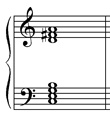Free Lessons
Cool chords to use at the end of a song
Most of us know that songs usually end on I chords. I say “usually” because in recent years, that is changing. But for the purpose of this post, I am going to discuss only the I chord. However, I want to start moving you away from the simple I major triad to much more interesting options all within the family of the I chord.
First of all, here are typical endings to songs (in the key of C) that we are all used to. They all utilize a simple C major triad.

A very simple thing you can do that actually makes a big difference is to just insert the 2nd into the chord. The 2nd in the case of a C chord is D, but you can easily find the second by going up 2 half steps from the root of the chord.
Here are some examples that utilize the 2nd.
To take this to a new level though, we need to add the major 7th to this chord. In the key of C, that means adding a B, but you can easily find the major 7th by going down a half step from the root.
Here are some examples. Do not play the root of the chord as the top note. If you avoid that, the major 7th sounds great. It is a dissonant, interesting sound.

Once you add the major 7th, you have unlocked the 9th, #11th, and #13 and you can experiment with them as well. You can find these notes by going up 2 half steps from the root and then playing a major triad. For example, when playing a C chord, going up two half steps to D and play the D major triad. The 9th is D, the #11th is F# and the 13th is A.
Here is the full C Major 7th chord with the 9th, #11th and 13th. Note that it looks like a D major triad stacked on top of a C chord.

Note that the 2nd we talked about earlier and the 9th are the same note (D). You call it a 2nd if there is no 7th in the chord and a 9th if there is. Don’t ask why…
Why a #11 instead of just 11? It just sounds better.
This is the level at which you can get some very cool, textured sounds. Here are some examples and I want to emphasize this is just scratching the surface of the possibilities using the 9th, #11 and 13th. I would (and do) end songs with these kinds of chords.

Some of these will work in church and some will be distracting. You have to decide what makes sense. But here are a few thoughts to help you. I have heard people say that it is wrong for songs to end in an unresolved state. While the theology of such a statement is suspect in the first place, that debate is irrelevant here because these chords ARE resolved from a functional standpoint. They may not sound resolved in a way that many expect, but they are indeed resolved.
On the other hand, it makes no sense to play a song with simplistic harmony and then tack on a lush ending chord such as one of these last examples. That is only going to confuse and distract the listener. If you are playing primarily triads, stick with the examples toward the top of this post (adding 2nds and maybe the major 7ths) until your harmony matures.
And then, consider the church itself. Just because you can play these chords does not mean you should. Some churches just cannot deal with them or are not used to that sound.
